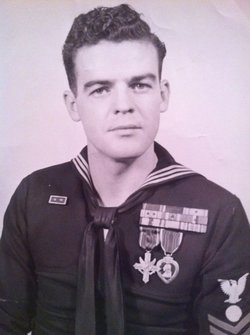CLAYBOURN-CHARLES
CHARLES VANCE "CHUCK" CLAYBOURN

CWO4

AN ILLUSTRIOUS CAREER
Charles Vance Claybourn was born on November 1921 in Chatham, Illinois. He enlisted in the Navy shortly before the start of World War II and was stationed aboard the submarine tender USS Canopus in the Philippines when the war began. As the Japanese advanced on the Philippines, Canopus became unusable and Claybourn was moved to Corregidor Island where he became a POW when it was captured by the Japanese in early May 1942. After being held for two years at Davao POW Camp he was placed aboard the Japanese ship Shinyo Maru with about 750 others to be moved to another POW camp in the Japanese empire. The Allies intercepted a message about the ship and not knowing it was carrying POWs, on September 7, 1944, the submarine USS Paddle fired torpedoes on it. The explosions resulted in many POWs being killed but Claybourn was one of the POWs who sought to escape from the sinking ship.
A subsequent War Department report stated, “Met by a withering hail of rifle fire from frenzied enemy guards on the deck of the rapidly sinking ship, Seaman First Class Claybourn instead of seeking escape undauntedly and courageously braved the fire unarmed in an effort to lead his group to safety. Evading every desperate measure of the frantic enemy to prevent him from rescuing his comrades, he conducted the wounded men to the side of the ship and remained until all had leaped into the water. While maddened enemy soldiers continued to fire on the defenseless and floundering men, he swam about with complete disregard for his life, helping the injured to keep afloat, pushing them toward floating timbers or bits of debris, shouting encouragement, and guiding the survivors shoreward. At length, despite utter physical exhaustion, he succeeded in bringing the group to shore, where they were assisted by Filipino guerrillas and ultimately returned to our forces. Seaman First Class Claybourn’s daring leadership, complete fearlessness, and intrepidity in repeatedly risking his life to aid his companions were responsible for saving many lives and were an inspiration to his stricken comrades.”
For his courageous actions, Claybourn received the Distinguished Service Cross and two Oak Leaf Clusters. He was one of the very few Navy men to earn the Distinguished Service Cross in World War II, and what makes his award ever rarer is that very few high awards were earned for actions by an individual being held as a POW. An article in the Saturday Evening Post wrote that when the survivors reached Brisbane, Australia, they learned they had two years back pay coming to them and they decided to throw a party.
The story goes on: “But their plan hit an early snag. No place could be found in which to stage it. Party-wise hotel managers shook their heads sadly. No space available for such a gathering, they said. The war, you know. And then one night shortly before their departure, they got a break. They met a stranger who didn’t merely manage a hotel, he owned one. Furthermore, he was anxious to sell it. The price was about $3,600. Divided among more than 40 boys, less than $90 each. So, they bought the hotel, and the party lasted for three nights and two days. On the morning of the third day, the men emerged, tired and triumphant, but puzzled as to what to do with their hotel. They were standing in front of it in a group when a very pretty blonde started up the block in their direction. They looked at her, then at one another, then nodded solemnly. As she came up to them, the first man’s arms closed around her. He planted a resounding kiss on her cheek and passed her on to the next. One by one, before she could protest, each man gave her a similar token of admiration. And when they were all through, THEY GAVE HER THE HOTEL.”
Charles Vance Claybourn remained in the Navy following World War II until retiring with the rank of Warrant Officer Four. After leaving the Navy, he settled in Kingsport, Tennessee, where he was a factory sales manager which manufactured one-way opaque glass. He died on November 15, 1986, survived by his wife who served in the Navy as a Storekeeper Second Class during World War II. They are both buried at Beaufort National Cemetery in Beaufort, South Carolina.
Submitted by CDR Roy A. Mosteller, USNR (Ret)

